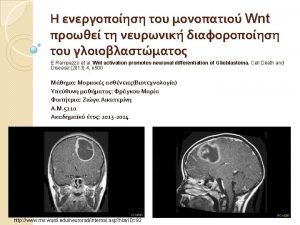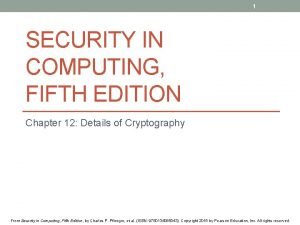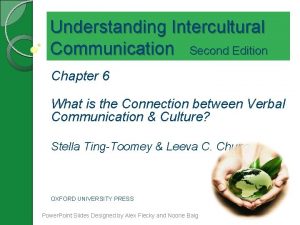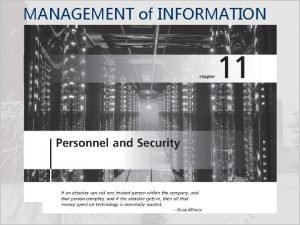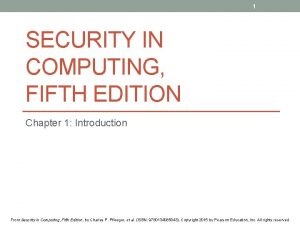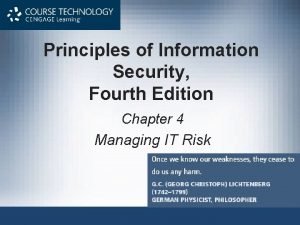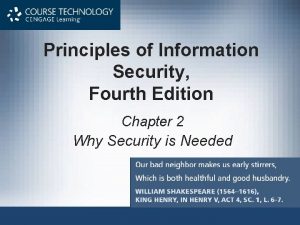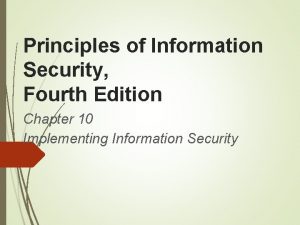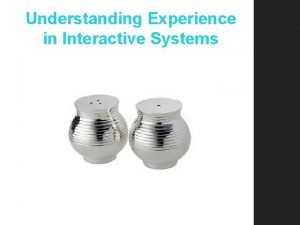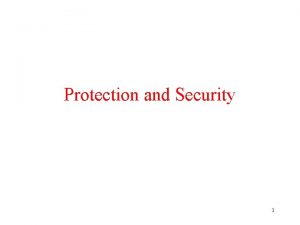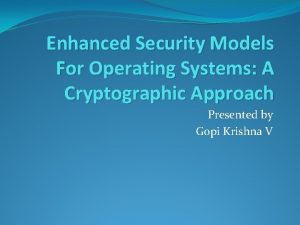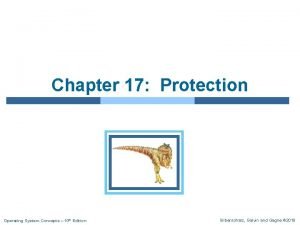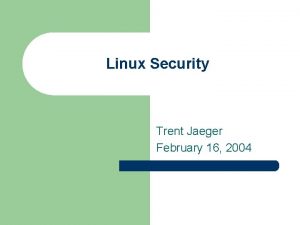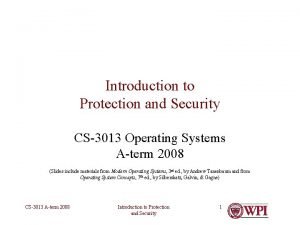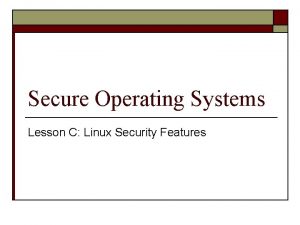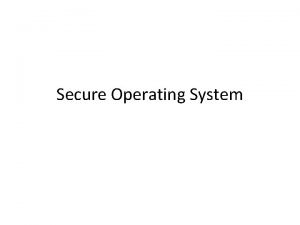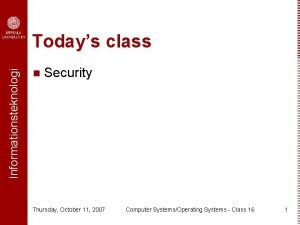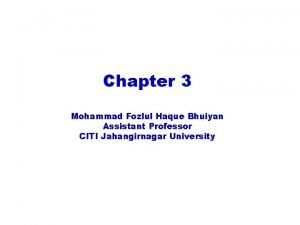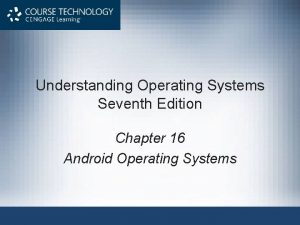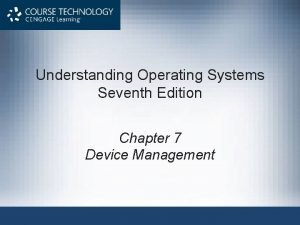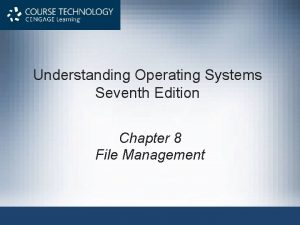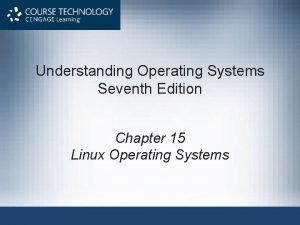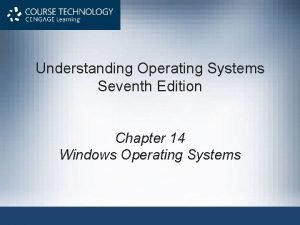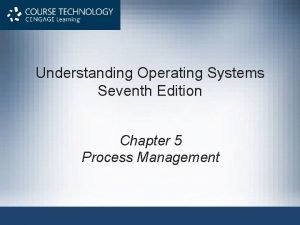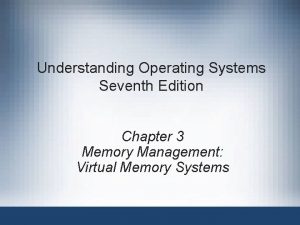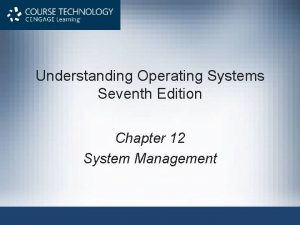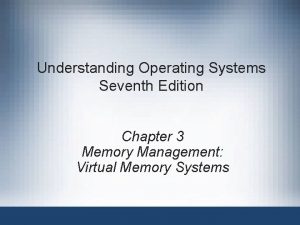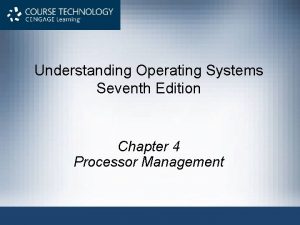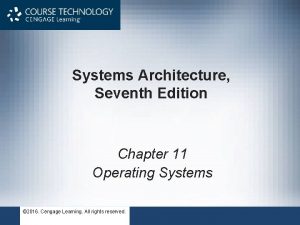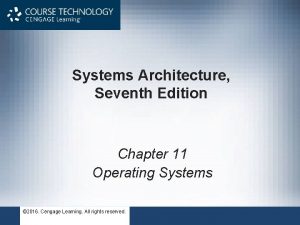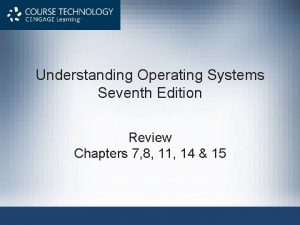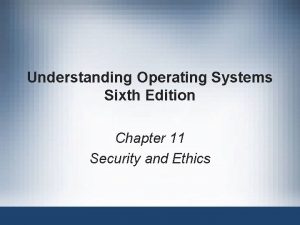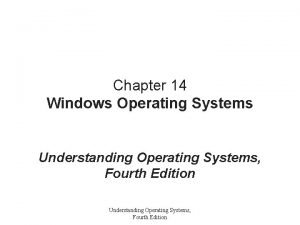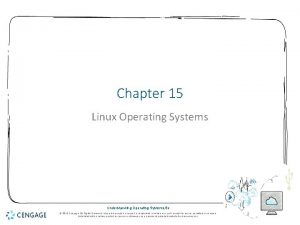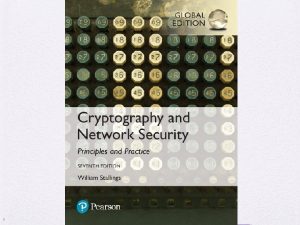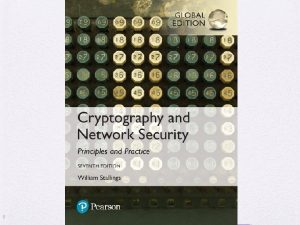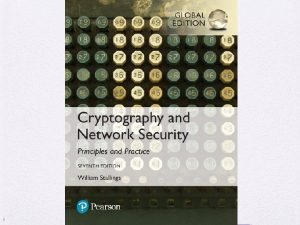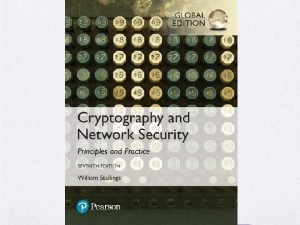Understanding Operating Systems Seventh Edition Chapter 11 Security




















































- Slides: 52

Understanding Operating Systems Seventh Edition Chapter 11 Security and Ethics

Learning Objectives After completing this chapter, you should be able to describe: • The role of the operating system with regard to system security • The effects of system security practices on overall system performance • The levels of system security that can be implemented and the threats posed by evolving technologies Understanding Operating Systems, 7 e 2

Learning Objectives (cont'd. ) • The differences among computer viruses, worms, and blended threats • The role of education and ethical practices in system security Understanding Operating Systems, 7 e 3

Role of the Operating System in Security • Key role – Operating system level vulnerability opens entire system to attack – Operating system complexity and power increases • More vulnerable to attack • System administrator’s role – Provide operating systems with all available defenses against attack Understanding Operating Systems, 7 e 4

System Survivability • System’s capability to fulfill mission – Timely manner – In presence of attacks, failures, or accidents • Survivable systems’ key properties – – Attack resistance Attack and resulting damage recognition Essential services recovery after attack System defense mechanism adaptation and evolution • Mitigate future attacks Understanding Operating Systems, 7 e 5

System Survivability (cont'd. ) (table 11. 1) Four key properties of a survivable system and strategies to achieve it. Details about the example strategies shown here can be found at www. cert. org. © Cengage Learning 2014 Understanding Operating Systems, 7 e 6

Levels of Protection • System administrator – Evaluate each computer configuration intrusion risk • Depends on connectivity level given to system Understanding Operating Systems, 7 e 7

(table 11. 2) A simplified comparison of security protection required for three typical computer configurations. Notice that system vulnerabilities accumulate as the computer’s level of connectivity increases. © Cengage Learning 2014 Understanding Operating Systems, 7 e 8

Backup and Recovery • Policies – Essential for most computing systems • System manager – Uses layered backup schedule • Backups – One set stored off-site • Crucial for disaster recovery • System management essential elements – Written policies and procedures – Regular user training Understanding Operating Systems, 7 e 9

Backup and Recovery (cont'd. ) • Written security procedures recommendations – – – – Frequent password changes Reliable backup procedures Guidelines for loading new software Software license compliance Network safeguards Guidelines for monitoring network activity Terminal access rules Understanding Operating Systems, 7 e 10

Security Breaches • System security gaps: malicious or otherwise • Intrusions classifications – Due to uneducated users and unauthorized access to system resources – Purposeful disruption of system operation – Purely accidental • Examples: hardware malfunctions, undetected errors in operating system or applications, natural disasters • Any security breach severely damages system credibility Understanding Operating Systems, 7 e 11

Unintentional Intrusions • Security breach or data modification – Not resulting from planned intrusion • Examples – Accidental incomplete modification of data • Nonsynchronized processes access data records • Modify some record fields – Errors due to incorrect data values storage • Field not large enough to hold numeric value stored Understanding Operating Systems, 7 e 12

Unintentional Intrusions (cont'd. ) (figure 11. 1) Data stored in variable length fields (top) shows all of the data in each field, but when data is stored in fixed length fields (bottom), critical data is truncated. © Cengage Learning 2014 Understanding Operating Systems, 7 e 13

Intentional Attacks • Attack types – Intentional unauthorized access • Denial of service attacks, browsing, wire tapping, repeated trials, trap doors, trash collection – – – Viruses Worms Trojans Logic bombs Blended threats Understanding Operating Systems, 7 e 14

Intentional Attacks (cont'd. ) • Intentional unauthorized access – Denial of service (Do. S) attacks • Synchronized attempts denying service to authorized users causing computer to perform repeated unproductive task – Browsing • Unauthorized users gain access to search through secondary storage directories or files for information they should not have the privilege to read Understanding Operating Systems, 7 e 15

Intentional Attacks (cont'd. ) • Intentional unauthorized access (cont'd. ) – Wire tapping • Unauthorized users monitor or modify transmission – Passive wire tapping: transmission monitored – Passive wire tapping reasons • Copy data while bypassing authorization procedures • Collect specific information (password) – Active wire tapping: modifying data • Methods include “between lines transmission” and “piggyback entry” Understanding Operating Systems, 7 e 16

Intentional Attacks (cont'd. ) • Intentional unauthorized access (cont'd. ) – Repeated trials • Enter system by guessing authentic passwords – Trap doors • Unspecified and undocumented system entry point • Diagnostician or programmer install • System vulnerable to future intrusion – Trash collection • Discarded materials (disks, CDs, printouts) to enter system illegally Understanding Operating Systems, 7 e 17

Intentional Attacks (cont'd. ) (table 11. 3) Average time required for a human and computer to guess passwords up to 10 alphabetic characters (A–Z) using brute force. © Cengage Learning 2014 Understanding Operating Systems, 7 e 18

Intentional Attacks (cont'd. ) • Malicious computer attacks – Possible state and federal law violation • Convictions – Significant fines and jail terms – Computer equipment confiscation Understanding Operating Systems, 7 e 19

Intentional Attacks (cont'd. ) • Viruses – Small programs altering computer operations • No user permission to run – Two criteria • Self-executing and self-replicating – Operating system specific (usually) – Spread using wide variety of applications – Macro virus • Attaches itself to template • In turn: attaches to word processing documents Understanding Operating Systems, 7 e 20

Intentional Attacks (cont'd. ) (table 11. 4) Five types of viruses. © Cengage Learning 2014 Understanding Operating Systems, 7 e 21

Intentional Attacks (cont'd. ) • Worms – Memory-resident programs – Copies itself from one system to next • No aid from infected program file – Slower processing time of real work – Especially destructive on networks • Trojans – Destructive programs • Disguised as legitimate or harmless program – Allows program creator secret access to system Understanding Operating Systems, 7 e 22

Intentional Attacks (cont'd. ) • Logic bombs – Destructive programs with fuse (triggering event) • Keystroke or connection with Internet – Spread unnoticed throughout network • Time bombs – Destructive programs triggered by specific time • Day of the year • Blended threats – Logic bomb and time bomb characteristics combined • Single program including virus, worm, Trojan, spyware, and other malicious code Understanding Operating Systems, 7 e 23

Intentional Attacks (cont'd. ) • Blended threats (cont'd. ) – Characteristics • • • Harm affected system Spread to other systems using multiple methods Attack other systems from multiple points Propagate without human intervention Exploit vulnerabilities of target systems – Protection • Combination of defenses with regular patch management Understanding Operating Systems, 7 e 24

System Protection • Threats arise from outsiders and insiders • Multifaceted system protection • Protection methods – Antivirus software, firewalls, restrictive access, and encryption Understanding Operating Systems, 7 e 25

Antivirus Software • Combats viruses only – Preventive, diagnostic, or both – Preventive programs calculate checksum for each production program – Diagnostic software compares file sizes and looks for replicating instructions or unusual file activity • Removes infection and leaves remainder intact – Sometimes • Cannot repair worms or Trojans – Malicious code in entirety Understanding Operating Systems, 7 e 26

Antivirus Software (cont'd. ) (table 11. 5) System security is a rapidly changing field. As of this writing, current information can be found at these Web sites, which are listed here in alphabetical order. © Cengage Learning 2014 Understanding Operating Systems, 7 e 27

Firewalls • Set of hardware and/or software – Designed to protect system – Disguises IP address from unauthorized users • Sits between Internet and network • Blocks curious inquiries and potentially dangerous intrusions – From outside system Understanding Operating Systems, 7 e 28

Firewalls (cont'd. ) (figure 11. 4) In this example of a university system, the firewall sits between the campus networks and the Internet, filtering requests for access. © Cengage Learning 2014 Understanding Operating Systems, 7 e 29

Firewalls (cont'd. ) • Typical firewall tasks – Log activities accessing Internet – Maintain access control • Based on senders’ or receivers’ IP addresses – Maintain access control • Based on services requested – Hide internal network from unauthorized users – Verify virus protection installed and enforced – Perform authentication • Based on source of a request from the Internet Understanding Operating Systems, 7 e 30

Firewalls (cont'd. ) • Firewall mechanisms to perform tasks – Packet filtering – Proxy servers • Packet filtering – Firewall reviews header information • Incoming and outgoing Internet packets • Verify source address, destination address, protocol authenticity Understanding Operating Systems, 7 e 31

Firewalls (cont'd. ) • Proxy server – Hides important network information from outsiders • Network server invisible – Determines validity of network access request – Invisible to users – Critical to firewall success Understanding Operating Systems, 7 e 32

Authentication • Verifying authorization of individual accessing system • Kerberos – Network authentication protocol – Provides strong authentication for client/server applications – Uses strong cryptography – Requires systematic revocation of access rights from clients • Who no longer deserve access Understanding Operating Systems, 7 e 33

Authentication (cont'd. ) (figure 11. 5) Using Kerberos, when client A attempts to access server B, the user is authenticated (a) and receives a ticket for the session (b). Once the ticket is issued, client and server can communicate at will (c). Without the ticket, access is not granted. © Cengage Learning 2014 Understanding Operating Systems, 7 e 34

Encryption • Extreme protection method – Sensitive data put into secret code – System communication • Data encrypted, transmitted, decrypted, processed • Disadvantages – Increased system overhead – System dependent on encryption process itself Understanding Operating Systems, 7 e 35

How Encryption Works • Involves a public key and a private key • Private key – Pair of two prime numbers (usually 75 or more digits each) – Chosen by private message recipient • Public key – Third number: product of the two prime numbers – Posted publicly – Encryption software inserts the public key as a variable in confidential message Understanding Operating Systems, 7 e 36

Encryption (cont'd. ) • Sniffers – Programs on computers attached to network • Peruse data packets as they pass by • Examine each packet for specific information • Particularly problematic in wireless networks • Spoofing – Assailant fakes IP address of Internet server • Changes address recorded in packets sent over Internet – Unauthorized users disguise themselves as friendly sites Understanding Operating Systems, 7 e 37

Password Management • Basic techniques protect hardware and software – Good passwords – Careful user training Understanding Operating Systems, 7 e 38

Password Construction • Good password – Unusual, memorable, not obvious, and changed often • Password files – Stored in encrypted form Understanding Operating Systems, 7 e 39

(figure 11. 7) Password verification flowchart showing how the user’s password is compared to its encrypted form. © Cengage Learning 2014 Understanding Operating Systems, 7 e 40

Password Construction (cont'd. ) • Good password techniques – Use minimum of eight characters • Including numbers and symbols – Create misspelled word • Join bits of phrases into word easy to remember – – Follow certain pattern on the keyboard Create acronyms from memorable sentences Use upper and lowercase characters (if allowed) Avoid words in any dictionary Understanding Operating Systems, 7 e 41

Password Construction (cont'd. ) (table 11. 6) Number of combinations of passwords depending on their length and available character sets. © Cengage Learning 2014 Understanding Operating Systems, 7 e 42

Password Construction (cont'd. ) • Dictionary attack – Method of breaking encrypted passwords – Requirements • Copy of encrypted password file • Algorithm used to encrypt passwords – Prevention • “Salt” user passwords with extra random bits • Makes dictionary attacks more difficult and time consuming than guessing obvious passwords Understanding Operating Systems, 7 e 43

Password Alternatives • Smart card use – Credit card-sized calculator • Requires “something you have and something you know” – Displays constantly changing multi-digit number • Synchronized with identical number generator in system – User must enter number appearing on smart card • Added protection: user enters secret code – User admitted to system if both number and code validated Understanding Operating Systems, 7 e 44

Password Alternatives (cont'd. ) • Biometrics – Science and technology of identifying individuals • Based on each person’s unique biological characteristics – Current research focus • Analysis of human face, fingerprints, hand measurements, iris/retina, voice prints – Positively identifies person being scanned – Critical factor • Reducing margin of error – Expensive Understanding Operating Systems, 7 e 45

Password Alternatives (cont'd. ) • Picture passwords – Graphics and pattern clicks – Involves touch screen, mouse, or other pointing device • Establish sequence of clicks on photo/illustration – Repeat sequence to gain access • Advantages – Eliminates keyboard entries • Resistant to dictionary attack Understanding Operating Systems, 7 e 46

Password Alternatives (cont'd. ) (table 11. 7) Sample of possible combinations of alphanumeric passwords and picture passwords (adapted from Microsoft, 2013). © Cengage Learning 2014 Understanding Operating Systems, 7 e 47

Social Engineering • Technique – System intruders gain access to information about a legitimate user – Learn active passwords • • Looking in and around user’s desk for written reminder Trying logon ID as password Searching logon scripts Telephoning friends and coworkers to learn information (family member names, pet names, vacation destinations, hobbies, car model) Understanding Operating Systems, 7 e 48

Social Engineering (cont'd. ) • Phishing – Intruder pretends to be legitimate entity • Asks unwary user to reconfirm personal and/or financial information • Default passwords – Pose unique vulnerabilities • Widely known – Routinely shipped with hardware or software – Routinely passed from one hacker to next – Change immediately Understanding Operating Systems, 7 e 49

Ethics • Ethical behavior: Be good. Do good. – IEEE and ACM issued standard of ethics in 1992 – Apparent lack of computing ethics • Significant departure from other professions • Consequences of ethical lapses – Illegally copied software: lawsuits and fines – Plagiarism: illegal and punishable by law – Eavesdropping on e-mail, data, or voice communications: sometimes illegal and usually unwarranted Understanding Operating Systems, 7 e 50

Ethics (cont'd. ) • Consequences of ethical lapses (cont'd. ) – Cracking (hacking) • Owner and users question validity of system data – Unethical use of technology • Clearly the wrong thing to do • Activities to teach ethics – Publish policies clearly stating actions tolerated – Teach regular seminar including real-life case histories – Conduct open discussions of ethical questions Understanding Operating Systems, 7 e 51

Conclusion • A system is only as good as the integrity of stored data – Single security breach damages system’s integrity • Catastrophic or otherwise • Accidental or otherwise – Damaged integrity threatens viability of: • Best-designed system, its managers, its designers, and its users • Vigilant security precautions are essential Understanding Operating Systems, 7 e 52
 Principles of information security, 7th edition
Principles of information security, 7th edition Understanding operating systems
Understanding operating systems Modern operating systems 3rd edition
Modern operating systems 3rd edition Tanenbaum structured computer organization
Tanenbaum structured computer organization Human anatomy and physiology seventh edition marieb
Human anatomy and physiology seventh edition marieb Database system concepts seventh edition
Database system concepts seventh edition Molecular biology of the cell seventh edition
Molecular biology of the cell seventh edition Biology seventh edition
Biology seventh edition Understanding human communication 14th edition chapter 1
Understanding human communication 14th edition chapter 1 Business essentials 12th edition
Business essentials 12th edition Private security
Private security Security in computing 5th edition ppt chapter 2
Security in computing 5th edition ppt chapter 2 Understanding nutrition 13th edition rental
Understanding nutrition 13th edition rental Understanding movies 14th edition
Understanding movies 14th edition Understanding human differences 5th edition
Understanding human differences 5th edition Karst erosion
Karst erosion Understanding earth 7th edition
Understanding earth 7th edition Understanding earth 5th edition
Understanding earth 5th edition Understanding human communication 14th edition
Understanding human communication 14th edition Type of rock
Type of rock Understanding intercultural communication 2nd edition
Understanding intercultural communication 2nd edition Major 2
Major 2 Using mis 10th edition
Using mis 10th edition Using mis 10th edition
Using mis 10th edition Operating system
Operating system Operating system concepts 6th edition
Operating system concepts 6th edition Failure of supporting utilities and structural collapse
Failure of supporting utilities and structural collapse Network security essentials 5th edition pdf
Network security essentials 5th edition pdf Modulo table
Modulo table Computer security principles and practice 4th edition
Computer security principles and practice 4th edition Management of information security 5th edition
Management of information security 5th edition Cryptography and network security 6th edition pdf
Cryptography and network security 6th edition pdf Cryptography and network security 4th edition
Cryptography and network security 4th edition Security in computing 5th edition answers
Security in computing 5th edition answers Information asset classification worksheet
Information asset classification worksheet Computer security fundamentals 4th edition
Computer security fundamentals 4th edition Principles of information security 4th edition
Principles of information security 4th edition Bulls eye model in information security
Bulls eye model in information security Computer security principles and practice 4th edition
Computer security principles and practice 4th edition Cryptographic systems are generically classified by
Cryptographic systems are generically classified by Cryptography and network security pearson
Cryptography and network security pearson Understanding experience in interactive systems
Understanding experience in interactive systems Amchip
Amchip Protection and security in operating system
Protection and security in operating system Security and protection in operating system
Security and protection in operating system Security and protection in operating system
Security and protection in operating system Jaeger flask
Jaeger flask Protection and security in operating system
Protection and security in operating system Linux security features
Linux security features Mandatory protection system
Mandatory protection system Trojan horse in computer
Trojan horse in computer Operating system security
Operating system security Operating system security problems
Operating system security problems






